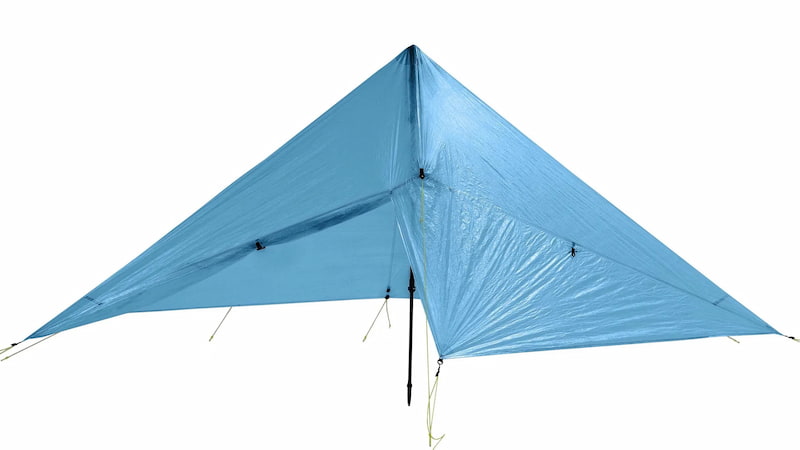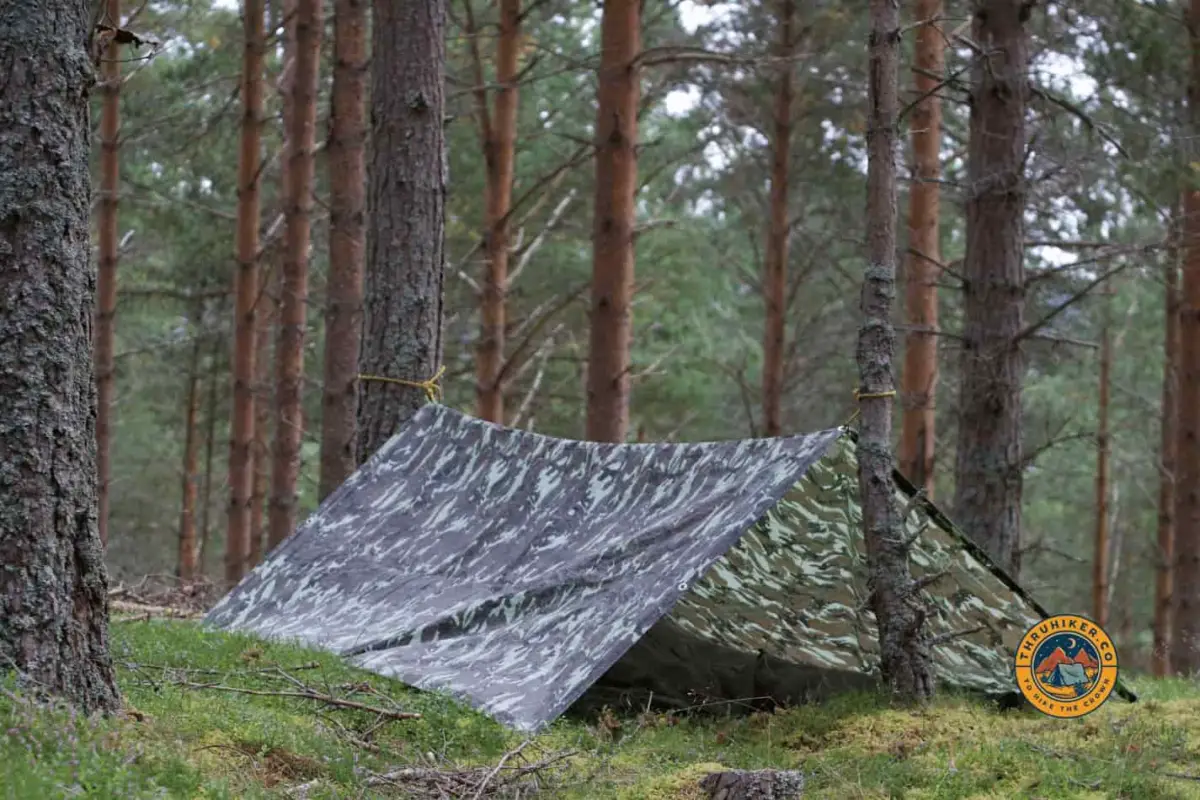For those who want to be the supreme ultralight backpacker, a backpacking tarp allows you to drop nearly all shelter weight while getting protection from the elements.
Let’s discuss what is a backpacking tarp and if using one for a hike is right for you.
Backpacking tarps offer simple coverage by using a trekking pole and some guylines and stakes to build a roof offering protection from the elements. Understanding site choice, tarp placement, and weather knowledge are crucial to safety.
Now that you know more about their versatility and the need to be prepared and knowledgeable, we can move on to how a backpacking tarp works, some keys to success when using one, and things to avoid.
The Ultralight Dream: What are Backpacking Tarps?
A backpacking tarp shelter is an ultralight piece of gear for a hiker. For many striving to drop base weight, carrying a tarp shelter is vital to hitting drastically low numbers while still being protected and comfortable.
Properly setting up a tarp can help to shelter you from the sun, wind, rain, and even snow with proper preparation and site selection.
Backpacker’s tarps are available in various shapes, the most common being flat tarps and rectangular tarps, along with materials, like Dyneema tarps.
In addition, they come in a wide variety of sizes with many different add-ons and features to help you find what you need, like this Zpacks Hexamid Pocket Tarp w/ Doors.
Mastering the Basics: How to Pitch a Backpacking Tarp
A backpacking tarp offers ultimate configuration value and ventilation in the backcountry as it can be easily pitched using a trekking pole or two and some cordage or guylines.
There are dozens of ways tarps can be pitched, so we will only review two of the most popular tarp pitches here but maybe cover more detail if you comment below with interest.
The A-Frame
One of the most popular and common ways to pitch a tarp is using an A-frame method using a trekking pole or decent stick to peak with.
This involves running a cord or guylines from each corner of the tarp to the center point and then staking them out. You can adjust the tension on each line until the tarp is tight and flat.
- Start by putting the two corners in. This will help you figure out how tall the shelter will be. The closer together the corners are, the taller the shelter will be.
- To set up the other side, you want to drive your pole into the ground. Next, adjust the height until it’s tight but still vertical. Finally, use a guy-line to secure the peg in place.
- Complete step 1 again, but with the other side
- Complete step 2 again.
- After you build the frame of your structure, go around and secure your tarp where any areas allow additional pegs depending on circumstances or weather needs. This will help keep it in place during windy conditions.
The Diamond Pitch
Another common way to pitch a backpacking tarp is what’s known as the diamond pitch.
This closes off three walls and leaves an open side that resembles a cave or enclosed space for protection but with visibility.
- First, take one corner of the tarp and tie it to a tree. Make sure the wind is blowing towards your back. For larger tarps, you should aim for six feet up the tree. If you have a smaller tarp or want a lower profile, go lower on the tree.
- Then go to the opposite corner and stake it out tight.
- And lastly, stake out each of the sides.
With the weather approaching from behind, you’ll have a nice, sheltered spot with a large opening so you can keep a visual of the surroundings.
Secrets of the Experts: Tips for Backpacking Tarp Success
When using a backpacking tarp, there are a few key things to remember for success.
Correct Tarp For Trail Needs
You can get many shapes in a tarp, and you must ensure you are selecting the right one for your use.
When using your tarp with a ground system or bivy sack, you will want a more rectangular one. If you are only using your tarp as a rainfly, you can get away with one that is more triangular or even hexagonal.
Your tarp’s weight and packed size are also important factors to consider. If you are looking for ultralight backpacking tarps, one made with Dyneema Composite Fabric or Cuben Fiber will be your lightest option.
For a tarp that doesn’t pack down as small, you can get away with one made of silnylon or polyester. These will be less expensive but not as strong as the Dyneema options.
Site Selection is Crucial
Unlike many other shelter options like tents or hammocks, your site selection is important as you will be exposed to the elements in a more primal way.
Things like dips in the ground, the wind coming through, and what is above you are things to look for when choosing your site.
Know Weather Conditions
Your tarp setup nightly will depend on the above and then on the expected weather and, more specifically, the weather in the area you settle in for camp.
Weather and overall conditions will help you choose how to set up your tarp for the most protection.
For example, if you are expecting rain, you will want to ensure you are on high ground and your tarp is pitched so that the rain will run off and not pool on top of the tarp and fall downhill from you. Or, should you expect high winds, you will want to ensure your lines are staked and tensioned correctly, so your tarp doesn’t become a kite.
Be Prepared to Adjust
As with most things in nature and backpacking, conditions are rarely what is predicted or what you expect them to be.
Be prepared to adjust on the fly and have extra materials like guy lines and stakes to make changes if needed.
One of the great things about using a tarp is the ability to be dynamic and adjust as conditions change.
Customize Your Setup: Popular Tarp Add-Ons for Comfort
While many choose to run a tarp and lines alone, some want some tweaks for more comfort and minimal weight increases.
Let’s look at the most common additions:
Noseeum Netting
This is for those who hate insects and being buzzed or bitten all night. You can add a noseeum net to your tarp and have a bug-free zone to sleep in without feeling claustrophobic.
Ensure the netting touches the ground for maximum protection but note that many ground-based bugs may still find their way underneath it.
Groundsheet
For people who don’t want to be directly on the ground, the groundsheet offers protection from the direct ground and any moisture that may be seeping up.
The most common groundsheet used with a tarp is a Tyvek sheet which is both lightweight and durable.
For those who want to raise edges, there is a fantastic DCF version from Zpacks, which offers a bathtub ledge.
Bivy
Similar to the two above in one package, a bivy offers ground protection and a noseeum netting to protect you from insects.
A bivy also offers a bit more warmth as you are somewhat cocooned. Be aware that some bivies don’t have a lot of headroom and can feel claustrophobic.

Embrace the Freedom of Ultralight Tarps
While not for everyone, tarp shelters are an excellent way to test your overall outdoor metal and see if you are open to more minimalist traveling; there’s no denying tarp camping is perfect for trying out.
If you are aiming for those elite levels, like the sub-seven pounds you can read about online, you will more than likely need to consider ultralight tarps as they are immensely less weight than any other shelter choice.
Do you use a tarp? Let us all know your thoughts and experiences on the best backpacking tarp in the comments!


Leave a Comment